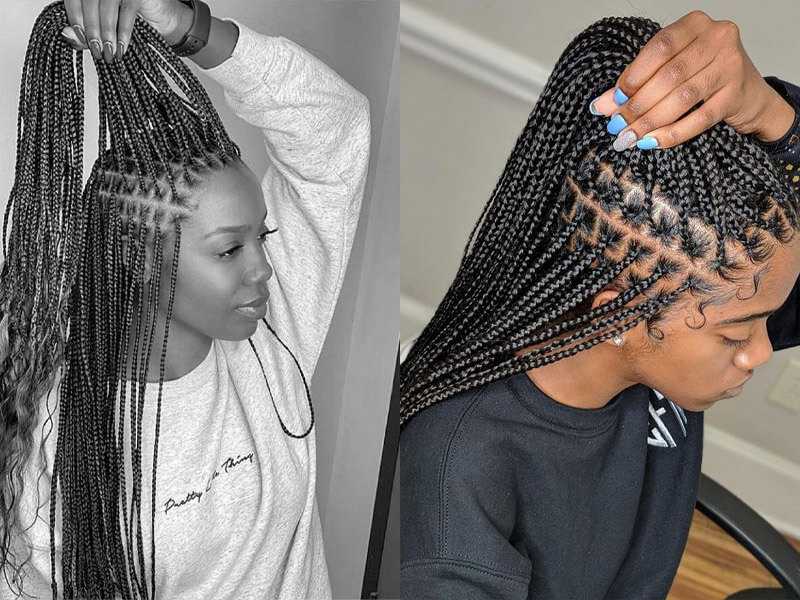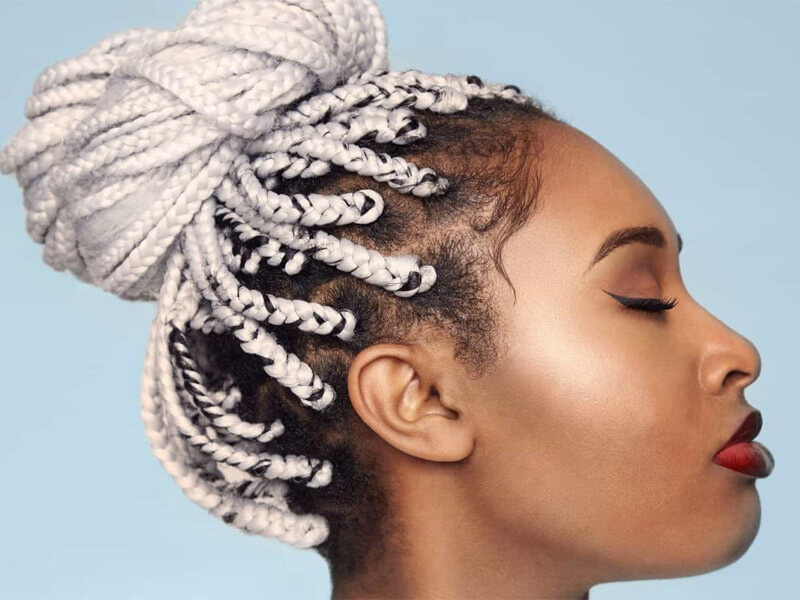Blog, Hair style
Knotless vs Knot Braids: Which Braiding Technique is Right for You?
Braids have long been a popular and versatile hairstyle, but when it comes to choosing between “knotless vs knot braids,” the decision can be confusing. Each technique has its own charm and benefits, and it’s important to clarify the differences. In this post, we’ll explore the world of knotless braids vs knot braids to help you find the best option for your hair type, lifestyle, and preferences.

What Are Knot Braids?

Knot braids, also known as box braids, are a classic hairstyling technique. They involve creating small sections of hair and tightly braiding them, securing each braid with a knot at the base. Knot braids are known for their neat and secure appearance, making them a popular choice for those seeking a polished and protective hairstyle.
What Are Knotless Braids?

Knotless braids are a modern twist on traditional braids. Unlike knot braids, they start with your natural hair at the base of the braid, creating a more natural and seamless look. Knotless braids are known for being lighter on the head and causing less tension on the scalp. They are also typically faster to install, making them a convenient choice for those looking for a stylish and comfortable hairstyle.
So, knot vs knotless braids: What is the difference? In the next parts, we will delve into the pros and cons of both these techniques.
Related post: Top 15 Eye-catching Hairstyles With Knotless Braid
Knotless Vs Knot Braids At A Glance
Before making your braiding decision, it’s important to understand the distinctions between knotless braids vs knot braids.
Pros And Cons Of Knot Braids
Box knot braids have been a popular protective hairstyle worldwide for a long time. Here are some key pros and cons to consider when choosing your next hairstyle.
Pros of Knot Braids
- Neat and Secure: Knot braids are known for their tidy and secure appearance. The knots at the base of each braid ensure that your hairstyle stays in place for an extended period.
- Versatility: Knot braids offer versatility in terms of length, thickness, and color. You can experiment with various styles and even add extensions to achieve your desired look.
- Durable: Knot braids tend to be long-lasting, making them a convenient choice for those who prefer low-maintenance hairstyles.

Cons of Knot Braids
- Time-Consuming: Installing knot braids can be time-intensive due to the precision required for tight knots.
- Scalp Tension: The tight knots may cause discomfort or tension on the scalp, particularly for those with sensitive scalps.
- Heaviness: Depending on the thickness and length of the braids, knot braids can feel heavy on the head, which might be uncomfortable for some individuals.
- Maintenance: Knot braids require regular maintenance to prevent frizz and maintain their neat appearance. This includes re-braiding loose sections and moisturizing the scalp.
Pros And Cons Of Knotless Braids
Knotless Braids offers numerous advantages, but it’s essential to be aware of a few important considerations before opting for this style.
Pros of Knotless Braids
- Natural Appearance: Knotless braids start with your natural hair at the base, creating a more seamless and natural look.
- Reduced Scalp Tension: These braids are gentler on the scalp because they lack the tight knots at the base, making them a comfortable option for those with sensitive scalps.
- Faster Installation: Knotless braids are typically quicker to install compared to traditional knot braids, saving you time at the salon.
- Lightweight: They feel lighter on the head due to their less bulky appearance, enhancing overall comfort.

Cons of Knotless Braids
- Limited Versatility: Knotless braids may not offer as much versatility in terms of length and thickness compared to knot braids. However, you can still use extensions to achieve your desired look.
- Maintenance: Like all braided styles, knotless braids require regular maintenance to prevent frizz and keep them looking neat and fresh.
- Skill Level: Finding a stylist experienced in knotless braids can be more challenging in some areas, so it may require some research to find the right professional.
Ultimately, the choice between knot vs knotless braids depends on your personal preferences and needs. Knotless braids are an excellent option for those seeking a more natural and comfortable style, while traditional knot braids offer a classic and polished look with their own set of advantages and considerations.
How Long Do Knotless And Knot Braids Last?
The longevity of knotless vs knot braids varies depending on their size and length. Smaller braids typically last around 12 weeks, medium-sized braids last approximately 8 weeks, and larger, longer braids can endure for up to 6 weeks.

However, it’s essential to consider that the expertise of your hairstylist and the technique they use play a significant role in the braids’ durability. Choosing a skilled professional is crucial to make sure that your braids maintain their quality and last as expected. Without proper handling, even well-sized braids may not last a month.
Knotless vs Knot Braids Care Tips
The care tips for knot box braids vs knotless are essential for maintaining both your scalp’s health and the quality of your braided hairstyle: Here are the tips you need to keep in mind:

1. Washing
You can wash both knotless and knot braids like regular hairstyles. Dilute shampoo with water in a spray bottle and shake it to create suds before applying to your hair. Avoid vigorous rubbing to prevent unraveling. It’s recommended not to wash these braided styles more than five times a month to maintain the knot’s integrity over time.
2. Moisturize
Moisturizing your scalp is crucial. It helps your scalp produce natural oils, preventing dryness and flakes. A well-moisturized scalp is essential for healthy hair. Additionally, moisturizing your hair itself maintains softness and glossiness, making it look natural, healthy, and soft.
3. Bedtime Routine

Protect your braids while sleeping by tying them into a loose ponytail and covering your head with a satin scarf. Your sleeping posture and pillowcase material play a significant role. Silk pillowcases prevent hair breakage and split ends, allowing your hair to move freely without being pulled.
Read more: How To Sleep With Box Braids Without Damaged Hair
4. Use a Bonnet
Bonnets are excellent for protecting your braids from tangling, breakage, and frizz while you sleep. You can use a bonnet even when your hair is slightly wet, but ensure it’s not soaking wet before covering it.
5. Protect Your “Baby Hairs”

Be cautious with the fine hairs along your hairline, often referred to as “baby hairs.” These delicate hairs should not be incorporated into your braids to prevent damage to their follicles. Instruct your hairstylist to handle them gently when braiding near the hairline.
Final Words
So, in the battle of knotless vs knot braids: Which one is better?
Well, when choosing between regular box braids and knotless braids, consider your experience and comfort level. If you’re new to these styles or have concerns about tightness and potential damage to your hair, it’s recommended to opt for knotless braids. On the other hand, if you’re accustomed to tight hairstyles and have no issues with them, regular braids can be a suitable choice. Ultimately, the decision comes down to personal preference.
But if you’re looking for an alternative hairstyle that doesn’t require a lot of time, you might want to explore options like hair extensions. A reputable Vietnamese hair supplier like Apohair specializes in providing high-quality hair extensions and wigs. Enjoy the versatility of different hairstyles while taking care of your natural hair’s health!
Your next read: The Difference Between Knotless Braids and Box Braids












